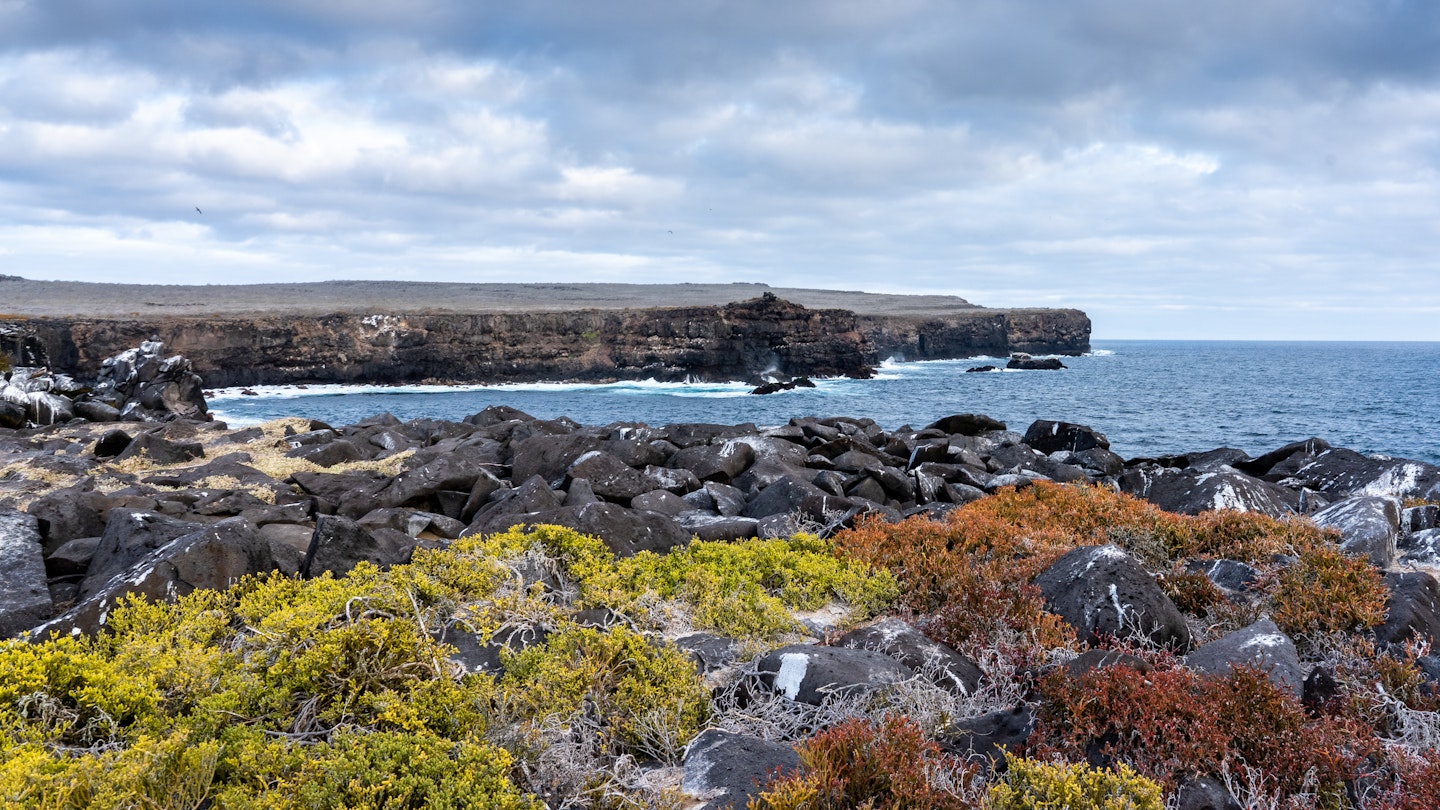Nature can be the best classroom and the Galápagos archipelago has much to teach us.
In a land of ancient tortoises and equatorial penguins, I fell for the humble mockingbird. About nine inches tall and with plumage that spans a dull spectrum of grays and browns, the Galápagos mockingbird seems like the kind of mundane specimen that blends seamlessly into the background. However, after repeated encounters while traveling across the volcanic archipelago, I started noticing – and becoming enamored by – the animal’s behaviors and quirks.
There were its angry hazel eyes, set permanently in the expression of someone whose parking spot had just been stolen. The birds showed no fear of lumbering humans as they skittered across sand as white as snow, or pecked at my backpack’s zippers with the persistence of an overeager customs agent. By observing closely, the distinguishing characteristics of the various subspecies emerged. On the island of San Cristóbal, the eponymous mockingbird variety showed an especially brash disregard for personal space, a result of just how few humans visit its shores. Conversely, the Española mockingbird has developed a longer beak, perfect for burrowing into albatross eggs for a snack.
Lesson #1: Follow the Rules

For most people, the Galápagos, a collection of 19 islands and hundreds of islets around 620 miles off the Pacific coast of mainland Ecuador, aren’t exactly a long weekend’s trip away. Like a Himalayan trek or an Antarctic cruise, this is a journey people save for. Most travelers arrive by plane from the Ecuadorian cities of Quito or Guayaquil, after which they either settle into one of the hotels on the most populated island, Santa Cruz, or board one of the many yachts and cruise ships that can be seen from the shoreline in the town of Puerto Ayora.

This isn’t a coincidence. Ships with capacities larger than 100 guests are not allowed to operate in the Galápagos. Additionally, for every group of 16 visitors to the Galápagos National Park, there must be one licensed naturalist guide. Adventure in the Galápagos is, by necessity, controlled. Even if you wanted to go off-the-grid, bushwhacking across one of the islands, you couldn’t. This reveals a contradiction at the heart of traveling in the Galápagos: you are there to experience one of the last wild places on Earth, but to do so, you need to stick to the trails, follow your guide’s directions, and be back on the boat before sunset.
Lesson #2: Go with the Flow
Most liveaboard travelers often choose between two itineraries. The western route focuses on the geologically younger islands of Fernandina and Isabela. In contrast, the eastern route passes through the first land formations that emerged here more than 4 million years ago. The geology and ecology of the Galápagos are so incredibly diverse from island to island that it can feel like playing a constant game of FOMO when selecting an itinerary. Choose the western route, and you’ll see the flightless cormorant, an icon of the islands’ penchant for bizarre species. However, if you pick the eastern one, you might encounter waved albatrosses engaged in elaborate courtship rituals, clacking their beaks and rocking their heads as if to some secret rhythm.

After a brief visit to El Chato Reserve, a farm where free-roaming Galápagos tortoises ambled without concern for tourists, I boarded a yacht in Puerto Ayora, and we were off. Each island has its own distinct ecosystem influenced by the evolution of species and the randomness of volcanic geology, making every landing feel like its own unique experience.
Lesson #3: Pay Attention
The Galápagos attracts diverse travelers, from charter yacht enthusiasts to hardcore scuba divers exploring the rich marine life beneath the waves. However, this archipelago is also famed as the intellectual spark for Charles Darwin’s Theory of Evolution. Within just a few days, you begin to understand what may have gone through Darwin’s mind nearly two centuries ago. This destination encourages contemplation, learning, and an expanded perspective on what is possible on our planet.

On my first day in the Galápagos, while touring the island of Santa Cruz, I overheard a conversation among fellow travelers. One guest was hesitant about participating in daily snorkeling activities, fearing she would not be adept. A young national park guide, Federico Zambrano, intervened, the urgency apparent in his tone. “You must get in the water,” he insisted. “At least half the magic of the Galápagos is underwater.”
Lesson #4: Lean into Learning
The Galápagos Islands and surrounding seas may seem otherworldly, but every detail possesses an explanation. Santiago Island showcases a never-ending sea of black lava flow, a brilliant example of volcanic activity frozen in time. Experiencing the phenomena, asking questions, and exploring educational resources onboard revealed how everything in the Galápagos serves a purpose. The dive-bombing boobies, for instance, possess specialized features in their skulls that protect their brains upon impact.

The tourism model in the Galápagos emphasizes conservation and education. Witnessing the unspoiled natural world ignites a desire to learn about and protect it further. This interconnectedness fosters a cycle of appreciation for nature’s wonders.
Lesson #5: Don’t Look Away; There’s Still Much to Do

It’s easy to depart the Galápagos feeling optimistic about conservation efforts amidst global challenges like climate change, rising sea levels, and extinction. While many travelers seek justification for their ecological footprint when visiting, the Galápagos presents a unique case where tourism significantly contributes to preserving pristine environments.
However, the threat of challenges to our natural world persists. Authorities seem dedicated to adhering to conservation restrictions, yet the landscape of tourism is evolving with an increasing presence of land-based tourism, potentially impacting sustainability. Although protective measures exist within the national park, there is an urgent need for balance in developing eco-friendly tourism that preserves the islands’ essence.
The Galápagos Islands serve as a poignant reminder of humanity’s responsibility to protect wild places, showcasing that both exploration and conservation demand our attention, action, and vigilance.





